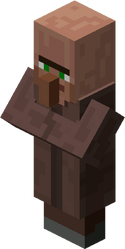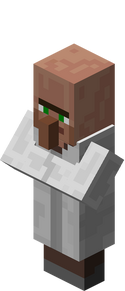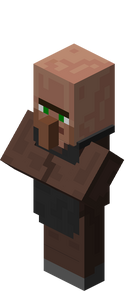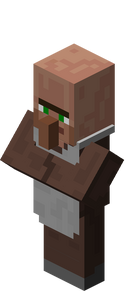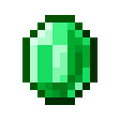Sin resumen de edición |
Sin resumen de edición |
||
| Línea 1: | Línea 1: | ||
{{traducir}} |
{{traducir}} |
||
| − | [[File:Trading paper clean GUI.png|thumb|352px|La |
+ | [[File:Trading paper clean GUI.png|thumb|352px|La interfaz de comercio desplegando un comercio de 20 de [[papel]] por 1 [[esmeralda]].]] |
El sistema de '''comercio''' es una mecánica de jugabilidad que permite a los [[Jugador|jugadores]] comerciar [[esmeralda]]s por [[objetos]] (y vice-versa) con [[aldeano]]s NPCs. |
El sistema de '''comercio''' es una mecánica de jugabilidad que permite a los [[Jugador|jugadores]] comerciar [[esmeralda]]s por [[objetos]] (y vice-versa) con [[aldeano]]s NPCs. |
||
| Línea 6: | Línea 6: | ||
== Funcionalidad == |
== Funcionalidad == |
||
| − | Haciendo |
+ | Haciendo clic derecho en un aldeano abrirá una GUI (menú) permitiendo al jugador comerciar con el aldeano. Los aldeanos harán ofertas basadas en su profesión, y sólo harán comercios basados en las ofertas que estén haciendo. Las diferentes ofertas pueden ser vistas presionando los botones de izquierda y derecha a la siguiente oferta actualmente desplegada. Todas las ofertas envuelve a la esmeralda con frecuencia, y algún objeto perteneciente a la profesión del aldeano. El comercio permite la adquisición de objetos no comunes que serían difíciles de obtener, como la armadura de cote malla. Es incluso el único método legítimo de adquirir la [[botella de experiencia]] en modo Supervivencia. |
Un aldeano nunca va a ofertar una compra/venta del mismo objeto en diferentes precios o cantidades (por ejemplo, ningún aldeano va a ofertar ya sea 16 de cerdo crudo o 17 de cerdo crudo: sólo puede haber una oferta a comprar cerdo crudo). Mientras tanto, las cantidades y precios pueden variar de aldeano en aldeano, y las propias cantidades/precios de un aldeano pueden cambiar para generar nuevas oferta. |
Un aldeano nunca va a ofertar una compra/venta del mismo objeto en diferentes precios o cantidades (por ejemplo, ningún aldeano va a ofertar ya sea 16 de cerdo crudo o 17 de cerdo crudo: sólo puede haber una oferta a comprar cerdo crudo). Mientras tanto, las cantidades y precios pueden variar de aldeano en aldeano, y las propias cantidades/precios de un aldeano pueden cambiar para generar nuevas oferta. |
||
| Línea 35: | Línea 35: | ||
! Cantidad |
! Cantidad |
||
! Precio en<br>[[esmeralda]]s |
! Precio en<br>[[esmeralda]]s |
||
| − | ! Valor de<br>Probabilidad<br><ref group="note" name="probability">Mayoría de ofertas tienen una probabilidad definida en el código. El numero |
+ | ! Valor de<br>Probabilidad<br><ref group="note" name="probability">Mayoría de las ofertas tienen una probabilidad definida en el código. El numero es largo, lo que quiere decir que es más probable que sea la oferta. Esto no es exactamente la probabilidad de tener la oferta: el juego primero compila una lista de posibles ofertas, y la probabilidad es usada a determinar si la oferta es incluida en esta lista. Entonces una oferta es seleccionada de esta lista aleatoriamente para ser la actual nueva oferta generada.</ref> |
| − | ! Actual<br>Probabilidad<br><ref group="note" name="actualProb">La |
+ | ! Actual<br>Probabilidad<br><ref group="note" name="actualProb">La probabilidad actual de una oferta depende en los valores de probabilidad de todas las ofertas por un aldeano. Estos valores fueron calculados revisando las probabilidades de todas las posibles listas de posibles ofertas.</ref> |
|- |
|- |
||
| style="text-align:left" | {{ItemLink|id=wheat|Trigo}} |
| style="text-align:left" | {{ItemLink|id=wheat|Trigo}} |
||
| Línea 65: | Línea 65: | ||
| 8 – 9 |
| 8 – 9 |
||
| 1 |
| 1 |
||
| − | | N/A<br><ref group="note" name="gold"> |
+ | | N/A<br><ref group="note" name="gold">Las ofertas de lingotes de oro no tienen un valor de probabilidad en el código, excepto por uno de los 2 herreros ofertadores. Si no se generan ofertas potenciales, entonces el juego será por defecto una oferta de lingotes de oro. Note que esta oferta es mas probable cuando todas las demás ofertas tienen una baja probabilidad.</ref> |
| 0.0044% |
| 0.0044% |
||
|} |
|} |
||
{| class="wikitable" style="text-align:center" |
{| class="wikitable" style="text-align:center" |
||
| − | ! colspan="5" | |
+ | ! colspan="5" | Venta |
|- |
|- |
||
| − | ! width="145px" | |
+ | ! width="145px" | Objeto |
| + | ! Cantidad |
||
| − | ! Quantity |
||
| − | ! |
+ | ! Precio en<br>[[esmeralda]]s |
| − | ! |
+ | ! Valor de<br>probabilidad |
| − | ! Actual<br> |
+ | ! Actual<br>Probabilidad |
|- |
|- |
||
| − | | style="text-align:left" | {{ItemLink| |
+ | | style="text-align:left" | {{ItemLink|id=bread|Pan}} |
| 3 – 4 |
| 3 – 4 |
||
| 1 |
| 1 |
||
| Línea 84: | Línea 84: | ||
| 16.0271% |
| 16.0271% |
||
|- |
|- |
||
| − | | style="text-align:left" | {{ItemLink| |
+ | | style="text-align:left" | {{ItemLink|id=melon|Sandía}} |
| 5 – 8 |
| 5 – 8 |
||
| 1 |
| 1 |
||
| Línea 90: | Línea 90: | ||
| 4.7690% |
| 4.7690% |
||
|- |
|- |
||
| − | | style="text-align:left" | {{ItemLink| |
+ | | style="text-align:left" | {{ItemLink|id=apple|Manzana}} |
| 5 – 8 |
| 5 – 8 |
||
| 1 |
| 1 |
||
| Línea 96: | Línea 96: | ||
| 4.7690% |
| 4.7690% |
||
|- |
|- |
||
| − | | style="text-align:left" | {{ItemLink| |
+ | | style="text-align:left" | {{ItemLink|id=cookie|Galleta}} |
| 8 – 10 |
| 8 – 10 |
||
| 1 |
| 1 |
||
| Línea 102: | Línea 102: | ||
| 4.7690% |
| 4.7690% |
||
|- |
|- |
||
| − | | style="text-align:left" | {{ItemLink| |
+ | | style="text-align:left" | {{ItemLink|id=shears|Tijeras}} |
| 1 |
| 1 |
||
| 3 |
| 3 |
||
| Línea 108: | Línea 108: | ||
| 4.7690% |
| 4.7690% |
||
|- |
|- |
||
| − | | style="text-align:left" | {{ItemLink| |
+ | | style="text-align:left" | {{ItemLink|id=flint-and-steel|Encendedor}} |
| 1 |
| 1 |
||
| 3 |
| 3 |
||
| Línea 114: | Línea 114: | ||
| 4.7690% |
| 4.7690% |
||
|- |
|- |
||
| − | | style="text-align:left" | {{ItemLink| |
+ | | style="text-align:left" | {{ItemLink|id=cooked-chicken|Pollo cocido}} |
| 7 – 8 |
| 7 – 8 |
||
| 1 |
| 1 |
||
| Línea 120: | Línea 120: | ||
| 4.7690% |
| 4.7690% |
||
|- |
|- |
||
| − | | style="text-align:left" | {{ItemLink| |
+ | | style="text-align:left" | {{ItemLink|id=arrow|Flecha}} |
| 9 – 12 |
| 9 – 12 |
||
| 1 |
| 1 |
||
| Línea 126: | Línea 126: | ||
| 8.2163% |
| 8.2163% |
||
|- |
|- |
||
| − | | style="text-align:left" | {{ItemLink| |
+ | | style="text-align:left" | {{ItemLink|id=flint|Pedernal}} |
| 4 – 5 |
| 4 – 5 |
||
| − | | 10 {{BlockLink| |
+ | | 10 {{BlockLink|id=gravel|Grava}} y<br>1 {{ItemLink|id=emerald|Esmeralda}} |
| 0.5 |
| 0.5 |
||
| 8.2163% |
| 8.2163% |
||
|} |
|} |
||
| − | === |
+ | === Bibliotecario === |
[[File:Librarian.png|right|125px]] |
[[File:Librarian.png|right|125px]] |
||
| Línea 145: | Línea 145: | ||
! Actual<br>Probability |
! Actual<br>Probability |
||
|- |
|- |
||
| − | | style="text-align:left" | {{ItemLink| |
+ | | style="text-align:left" | {{ItemLink|id=paper|Papel}} |
| 24 – 35 |
| 24 – 35 |
||
| 1 |
| 1 |
||
| Línea 151: | Línea 151: | ||
| 24.8384% |
| 24.8384% |
||
|- |
|- |
||
| − | | style="text-align:left" | {{ItemLink| |
+ | | style="text-align:left" | {{ItemLink|id=book|Libro}} |
| 11 – 12 |
| 11 – 12 |
||
| 1 |
| 1 |
||
| Línea 157: | Línea 157: | ||
| 24.8384% |
| 24.8384% |
||
|- |
|- |
||
| − | | style="text-align:left" | {{ItemLink| |
+ | | style="text-align:left" | {{ItemLink|id=written-book|Libro Escrito}} |
| 1 |
| 1 |
||
| 1 |
| 1 |
||
| Línea 163: | Línea 163: | ||
| 7.9476% |
| 7.9476% |
||
|- |
|- |
||
| − | | style="text-align:left" | {{ItemLink| |
+ | | style="text-align:left" | {{ItemLink|id=gold-ingot|Lingote de oro}} |
| 8 – 9 |
| 8 – 9 |
||
| 1 |
| 1 |
||
| Línea 211: | Línea 211: | ||
=== Priest === |
=== Priest === |
||
| − | [[File: |
+ | [[File:Sacerdote.png|right|125px]] |
{| class="wikitable" style="text-align:center" |
{| class="wikitable" style="text-align:center" |
||
| Línea 701: | Línea 701: | ||
{{reflist}} |
{{reflist}} |
||
| − | {{ |
+ | {{minecraft}} |
[[de:Handel]] |
[[de:Handel]] |
||
Revisión del 01:33 14 ago 2013
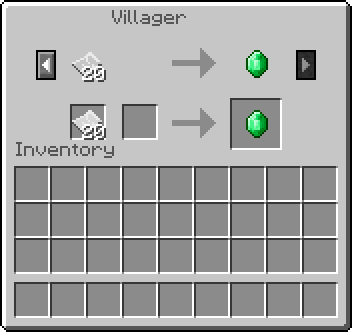
La interfaz de comercio desplegando un comercio de 20 de papel por 1 esmeralda.
El sistema de comercio es una mecánica de jugabilidad que permite a los jugadores comerciar esmeraldas por objetos (y vice-versa) con aldeanos NPCs.
Funcionalidad
Haciendo clic derecho en un aldeano abrirá una GUI (menú) permitiendo al jugador comerciar con el aldeano. Los aldeanos harán ofertas basadas en su profesión, y sólo harán comercios basados en las ofertas que estén haciendo. Las diferentes ofertas pueden ser vistas presionando los botones de izquierda y derecha a la siguiente oferta actualmente desplegada. Todas las ofertas envuelve a la esmeralda con frecuencia, y algún objeto perteneciente a la profesión del aldeano. El comercio permite la adquisición de objetos no comunes que serían difíciles de obtener, como la armadura de cote malla. Es incluso el único método legítimo de adquirir la botella de experiencia en modo Supervivencia.
Un aldeano nunca va a ofertar una compra/venta del mismo objeto en diferentes precios o cantidades (por ejemplo, ningún aldeano va a ofertar ya sea 16 de cerdo crudo o 17 de cerdo crudo: sólo puede haber una oferta a comprar cerdo crudo). Mientras tanto, las cantidades y precios pueden variar de aldeano en aldeano, y las propias cantidades/precios de un aldeano pueden cambiar para generar nuevas oferta.
Inicialmente todos los aldeanos tienen una sola oferta para hacer. Ellos pueden generar nuevas ofertas cuando la última oferta disponible (mas a la derecha en su lista de ofertas) ha sido comerciada al menos una vez. Dese cuenta que la GUI de comercio debe ser cerrada antes de que un aldeano vaya a generar una nueva oferta. Cuando se hace, ellos se rodean de partículas verdes y moradas por un momento. Las nuevas ofertas pueden envolver objetos que un aldeano ya estuvo comprando/vendiendo: en este caso, la más nueva oferta generada va a sustituir la anterior, permitiendo a los precios del aldeano (o encantamientos del sacerdote) a cambiar. Aunque no hay un limite máximo en el número de ofertas que un aldeano individual pueda hacer, ellos solo pueden tener una oferta para cada tipo de objeto que puedan comerciar. Además, cuando un aldeano ya tiene varias ofertas, hay una alta probabilidad que una oferta generada mucho más nueva vaya ha ser de un objeto que ya ha sido ofertada: así la vieja oferta va ha ser sustituida, y no va a haber ningún espacio a añadir al aldeano a cualquier nueva oferta.
Los aldeanos desactivan una oferta si ésta ha sido usada varias veces y siempre y cuando no sea la única oferta del aldeano. La posibilidad de la desactivación de una oferta es aleatoria, pero una oferta debe se usada al menos 3 veces para ser elegible a desactivación. Después de que una oferta ha sido usada 13 veces, es garantizada ha ser desactivada si tu cierras la interfaz después de comercializarlo (esto es verdad incluso si todos los 13 comercios han sido hecho de una vez). Comerciando la última oferta puede activar una oferta de nuevo.
Antes de la Pretty Scary Update (v1.4), era posible comerciar mas de 13 veces una sola oferta porque éstas no fueron removidas hasta que la interfaz de comercio fuera cerrada. Esto quería decir que tu podías comprar una oferta tantas como te permitiera tu inventario. Actualmente, los aldeanos pueden detener el comercio en un objeto en particular una vez que se han cumplido las condiciones para la desactivación, incluso si la ventana de comercio sigue abierta. Esto puede causar comportamientos extraños en el inventario cuando el jugador esta usando "shift" y clic cuando está comerciando. Al principio parece que todas las cosas han sido comerciadas, pero después de tomar una acción en el inventario el amonto de las esmeraldas y las cosas en el inventario del usuario cambian. Una vez que la ventana de comercio es cerrada y reabierta, la oferta va a seguir desplegada, pero la X roja va a indicar que la oferta ya no esta disponible. Mientras tanto, sólo una oferta puede ser removida después de que la interfaz de comercio es cerrada: si tú comercias múltiples ofertas más del límite, sólo la última comerciada va a ser removida. De este modo, una oferta con mas de 13 usos puede ser mantenida y el juego no revisa las ofertas para ser deshabilitada hasta que la oferta es comerciada.
Además, si una oferta es la última disponible, nunca se desactiva incluso si se exceden los 13 usos. Una vez que ya no esta la última oferta, por supuesto, es elegible para ser deshabilitada. Cuando una oferta es deshabilitada, tiene el mismo efecto de partículas como una oferta siendo creada.
Aunque, desafortunadamente, tu no puedes cambiar que es lo que un aldeano va a vender, para eso tu vas a tener que comerciar hasta que todos los objetos sean desbloqueados.
Posibles ofertas
Rápida referencia a la tabla de comercio
La tabla siguiente enlista los objetos mínimos y máximos que un aldeano puede hacer comprando y vendiendo.
Granjero
| Compra | ||||
|---|---|---|---|---|
| Objeto | Cantidad | Precio en esmeraldas |
Valor de Probabilidad [note 1] |
Actual Probabilidad [note 2] |
| Trigo | 18 – 21 | 1 | 0.9 | 16.0271% |
| Lana | 14 – 21 | 1 | 0.5 | 8.2163% |
| Pollo crudo | 14 – 17 | 1 | 0.5 | 8.2163% |
| Pescado cocido | 9 – 12 | 1 | 0.4 | 6.4622% |
| Lingote de oro | 8 – 9 | 1 | N/A [note 3] |
0.0044% |
| Venta | ||||
|---|---|---|---|---|
| Objeto | Cantidad | Precio en esmeraldas |
Valor de probabilidad |
Actual Probabilidad |
| Pan | 3 – 4 | 1 | 0.9 | 16.0271% |
| Sandía | 5 – 8 | 1 | 0.3 | 4.7690% |
| Manzana | 5 – 8 | 1 | 0.3 | 4.7690% |
| Galleta | 8 – 10 | 1 | 0.3 | 4.7690% |
| Tijeras | 1 | 3 | 0.3 | 4.7690% |
| Encendedor | 1 | 3 | 0.3 | 4.7690% |
| Pollo cocido | 7 – 8 | 1 | 0.3 | 4.7690% |
| Flecha | 9 – 12 | 1 | 0.5 | 8.2163% |
| Pedernal | 4 – 5 | 10 Grava y 1 Esmeralda |
0.5 | 8.2163% |
Bibliotecario
| Buys | ||||
|---|---|---|---|---|
| Item | Quantity | Price in emeralds |
Probability Value |
Actual Probability |
| Papel | 24 – 35 | 1 | 0.8 | 24.8384% |
| Libro | 11 – 12 | 1 | 0.8 | 24.8384% |
| Libro Escrito | 1 | 1 | 0.3 | 7.9476% |
| Lingote de oro | 8 – 9 | 1 | N/A[note 3] | 0.2666% |
| Sells | ||||
|---|---|---|---|---|
| Item | Quantity | Price in emeralds |
Probability Value |
Actual Probability |
| Bookshelf | 1 | 3 | 0.8 | 24.8384% |
| Enchanted Book[note 4] | 1 | 1 Book and 5 – 71 Emeralds |
0.07 | 1.7573% |
| Glass | 4 – 5 | 1 | 0.2 | 5.1711% |
| Compass | 1 | 10 – 11 | 0.2 | 5.1711% |
| Clock | 1 | 10 – 11 | 0.2 | 5.1711% |
Priest
| Buys | ||||
|---|---|---|---|---|
| Item | Quantity | Price in emeralds |
Probability Value |
Actual Probability |
| Gold Ingot | 8 – 9 | 1 | N/A[note 3] | 15.6036% |
| Sells | ||||
|---|---|---|---|---|
| Item | Quantity | Price in emeralds |
Probability Value |
Actual Probability |
| Eye of Ender | 1 | 7 – 10 | 0.3 | 16.1039% |
| Bottle o' Enchanting | 2 – 4 | 1 | 0.2 | 10.2716% |
| Redstone | 2 – 4 | 1 | 0.4 | 22.5541% |
| Glowstone | 2 – 3 | 1 | 0.3 | 16.1039% |
| Enchants[note 5] | |||
|---|---|---|---|
| Item | Price in emeralds |
Probability Value |
Actual Probability |
| Iron Sword | 2 – 4 | 0.1 | 2.4204% |
| Iron Pickaxe | 2 – 4 | 0.1 | 2.4204% |
| Iron Axe | 2 – 4 | 0.1 | 2.4204% |
| Diamond Sword | 2 – 4 | 0.1 | 2.4204% |
| Diamond Pickaxe | 2 – 4 | 0.1 | 2.4204% |
| Diamond Axe | 2 – 4 | 0.1 | 2.4204% |
| Iron Chestplate | 2 – 4 | 0.1 | 2.4204% |
| Diamond Chestplate | 2 – 4 | 0.1 | 2.4204% |
Blacksmith
| Buys | |||||
|---|---|---|---|---|---|
| Item | Quantity | Price in emeralds |
Price per Unit in emeralds |
Probability Value |
Actual Probability |
| Coal or Charcoal | 16 – 23 | 1 | 0.0435 - 0.0625 | 0.7 | 9.6382% |
| Iron Ingot | 8 – 9 | 1 | 0.111 - 0.125 | 0.5 | 6.6765% |
| Gold Ingot | 8 – 9 | 1 | 0.111 - 0.125 | 0.5 | 6.6817%[note 3][note 6] |
| Diamond | 4 – 5 | 1 | 0.2 - 0.25 | 0.5 | 6.6765% |
| Sells | |||||
|---|---|---|---|---|---|
| Item | Quantity | Price in emeralds |
Price per Unit Ingredient[note 7] |
Probability Value |
Actual Probability |
| Iron Sword | 1 | 7 – 10 | 3.5 - 5 | 0.5 | 6.6765% |
| Iron Axe | 1 | 6 – 7 | 2 - 2.33 | 0.3 | 3.8961% |
| Iron Pickaxe | 1 | 7 – 8 | 2.33 - 2.67 | 0.5 | 6.6765% |
| Iron Shovel | 1 | 4 – 5 | 4 – 5 | 0.2 | 2.5638% |
| Iron Hoe | 1 | 4 – 5 | 2 - 2.5 | 0.2 | 2.5638% |
| Diamond Sword | 1 | 12 – 13 | 6 - 6.5 | 0.5 | 6.6765% |
| Diamond Axe | 1 | 9 – 11 | 3 - 3.67 | 0.3 | 3.8961% |
| Diamond Pickaxe | 1 | 10 – 11 | 3.33 - 3.67 | 0.5 | 6.6765% |
| Diamond Shovel | 1 | 7 | 7 | 0.2 | 2.5638% |
| Diamond Hoe | 1 | 7 | 3.5 | 0.2 | 2.5638% |
| Iron Helmet | 1 | 4 – 5 | 0.8 - 1 | 0.2 | 2.5638% |
| Iron Chestplate | 1 | 10 – 13 | 1.25 - 1.625 | 0.2 | 2.5638% |
| Iron Leggings | 1 | 8 – 9 | 1.14 - 1.29 | 0.2 | 2.5638% |
| Iron Boots | 1 | 4 – 5 | 1 - 1.25 | 0.2 | 2.5638% |
| Diamond Helmet | 1 | 7 | 1.4 | 0.2 | 2.5638% |
| Diamond Chestplate | 1 | 16 – 18 | 2 - 2.25 | 0.2 | 2.5638% |
| Diamond Leggings | 1 | 11 – 13 | 1.57 - 1.86 | 0.2 | 2.5638% |
| Diamond Boots | 1 | 7 | 1.75 | 0.2 | 2.5638% |
| Chainmail Helmet | 1 | 5 – 6 | 1 – 1.2 | 0.1 | 1.2659% |
| Chainmail Chestplate | 1 | 11 – 14 | 1.375 – 1.75 | 0.1 | 1.2659% |
| Chainmail Leggings | 1 | 9 – 10 | 1.29 – 1.43 | 0.1 | 1.2659% |
| Chainmail Boots | 1 | 5 – 6 | 1.25 - 1.5 | 0.1 | 1.2659% |
Butcher
| Buys | ||||
|---|---|---|---|---|
| Item | Quantity | Price in emeralds |
Probability Value |
Actual Probability |
| Coal or Charcoal | 16 – 23 | 1 | 0.7 | 21.0549% |
| Raw Porkchop | 14 – 17 | 1 | 0.5 | 14.0096% |
| Raw Beef | 14 – 17 | 1 | 0.5 | 14.0096% |
| Gold Ingot | 8 – 9 | 1 | N/A[note 3] | 0.794% |
| Sells | ||||
|---|---|---|---|---|
| Item | Quantity | Price in emeralds |
Probability Value |
Actual Probability |
| Saddle | 1 | 6 – 7 | 0.1 | 2.5177% |
| Leather Cap | 1 | 2 – 3 | 0.3 | 7.9357% |
| Leather Tunic | 1 | 4 | 0.3 | 7.9357% |
| Leather Pants | 1 | 2 – 3 | 0.3 | 7.9357% |
| Leather Boots | 1 | 2 – 3 | 0.3 | 7.9357% |
| Cooked Porkchop | 6 – 7 | 1 | 0.3 | 7.9357% |
| Steak | 6 – 7 | 1 | 0.3 | 7.93571% |
Villager (green clothes)
Note: The green Villager is only obtainable using server commands, mods, or third-party map editors. It does not spawn naturally, even when using a spawn egg.
| Buys | ||||
|---|---|---|---|---|
| Item | Quantity | Price in emeralds |
Probability Value |
Actual Probability |
| Gold Ingot | 8 – 9 | 1 | N/A[note 3] | 100% |
Notas
- ↑ Mayoría de las ofertas tienen una probabilidad definida en el código. El numero es largo, lo que quiere decir que es más probable que sea la oferta. Esto no es exactamente la probabilidad de tener la oferta: el juego primero compila una lista de posibles ofertas, y la probabilidad es usada a determinar si la oferta es incluida en esta lista. Entonces una oferta es seleccionada de esta lista aleatoriamente para ser la actual nueva oferta generada.
- ↑ La probabilidad actual de una oferta depende en los valores de probabilidad de todas las ofertas por un aldeano. Estos valores fueron calculados revisando las probabilidades de todas las posibles listas de posibles ofertas.
- ↑ 3,0 3,1 3,2 3,3 3,4 3,5 Las ofertas de lingotes de oro no tienen un valor de probabilidad en el código, excepto por uno de los 2 herreros ofertadores. Si no se generan ofertas potenciales, entonces el juego será por defecto una oferta de lingotes de oro. Note que esta oferta es mas probable cuando todas las demás ofertas tienen una baja probabilidad.
- ↑ The enchantment is chosen randomly, with equal chance of any enchantment type occurring and equal chance to get any level of it, so higher-leveled enchantments are as likely to get as low-leveled enchantments. The price in emeralds depends on enchantment level only. The possible values are 5 – 19 emeralds for Lvl I, 8 – 32 for Lvl II, 11 – 45 for Lvl III, 14 – 58 for Lvl IV and 17 – 71 for Lvl V.
- ↑ Priests will offer to enchant items for you. Every enchantment costs between 2 – 4 emeralds, and requests the item to be enchanted in the first slot. Trading for an enchanted item in this manner repairs the item if it is damaged, allowing items to have infinite durability at the cost of emeralds. When creating the enchantment offer, the game uses a random enchantment level from 5 – 19. For a listing of what enchantments will show up at these levels, see Enchantment Mechanics
- ↑ The blacksmith actually has two chances to offer to buy gold ingots. This is because it is an explicit offer a smith may ordinarily make (0.5 probability value, or 6.6765% chance), and it is also a default offer for all villagers (with a 0.0052% chance from a blacksmith). Note that, despite two chances to generate a gold ingot offer each time an offer is generated, a blacksmith will never have two separate offers to buy gold ingots in the trading interface, because the offers involve the same items.
- ↑ "Price per Unit Ingredient" is the equivalent price per diamond gem or iron ingot that you would be paying if you were buying the diamonds or iron and then crafting the resulting tool or armor yourself. In the case of chainmail armor, these numbers are given for a theoretical comparison only, since chainmail cannot be player-crafted. In the case of tools, sticks used in the crafting of tools are ignored in the calculation.
Video
Comercio/Antes de Village & Pillage/video
History

The first image of the trading system released by Jeb.[1] The currency item (later updated to the emerald) can be seen in the inventory.
Before the Adventure Update, Notch once answered some questions about an idea he had, NPC Villages, where he revealed some thoughts about them:[2]
- If you treat the villagers well (giving them items), they'll give you items back.
- If you treat the villagers badly (attacking/killing them), they'll try to do the same to you (feature added with Iron Golems).
- Raiding chests will anger the owners of the town/chest and they will attack.
On May 21, 2012, Jeb released a screenshot of himself testing the Trading System.[1] The image shows a GUI with buying and selling areas. The bottom area allows the player to sell various items for currency, whereas the top area uses this currency to purchase items. A possible way to buy them would be to put these currencies in the left slot, where the chicken is, and you can scroll through items for the right slot to take the item you choose once you click on it. The player may use the arrow buttons to scroll through a villager's inventory and select the desired item. Jeb also mentioned that this may be an end to non-renewable resources, supposedly as most can be bought for some price from NPCs. In the image, a red currency item can be seen that was later revealed in snapshot 12w21a as a ruby item that was changed to emerald before 12w21a, for reasons unknown.
An ore block can be seen in the background which was later revealed in snapshot 12w21a to be Ruby Ore, which was changed to emerald ore before 12w21a because Dinnerbone is colorblind[3].
Another image released earlier by Jeb shows separated villagers.[4] This tweet also says "this is how I experiment with villagers". With spawn eggs for spawning random villagers, one would think that by keeping them separate Jeb was testing each profession of the villagers, perhaps because they each trade different items or would be.
With the implementation of the trading system, most or all resources become "renewable" since nonrenewable resources can be traded from villagers.[5]
As of snapshot 12w22a, Priests no longer offer to buy Rotten Flesh or Eyes of Ender. Eyes of Ender are now sold by priests, and rotten flesh is not a trade at all.
The trading UI has been changed where an extra input space has been added where tools can be placed for buying enchantments and/or repair.
Prior to snapshot 12w23a, the probability of a librarian buying a written book as a potential offer was 1.3 (130%), meaning it would always be a potential offer. This meant it was impossible for librarians to offer to buy gold ingots, as this is a default offer which occurs if no offers are put on the list of potential offers. This has been corrected in snapshot 12w23a.
In update 12w32a, trading was adjusted further. The librarian's paper offer was adjusted to 24-35 paper per emerald, and the farmer's arrow offer was corrected to 9-12 per emerald.
In addition, the offer probability mechanic was changed: as more offers exist for a villager, the probability of all offers rise. When an offer's probability goes beyond a certain limit, its probability goes down. The net effect is that rarer offers become more common when a villager has many offers, and common offers become rarer.
In addition, the offer removal mechanic has been replaced with an offer disabling mechanic: all offers begin with 7 'uses', allowing the offer to be traded up to seven times. After this, even if the player has not left the trading GUI, the offer is disabled - if a player has shift-clicked in an attempt to trade more than the limit, the items temporarily appear in the inventory but vanish as though the excess trades never happened. If a player trades the last offer on the list and closes the GUI, waiting for particles to appear around the villager, all disabled offers are renewed with 2-12 additional uses added to them. Due to the random distribution, the average amount of uses added is 7, and the amounts are weighted towards values in the middle of the range. Note that offers which are not disabled do not get extra uses. It is possible for the final offer slot to be disabled, at which point no new offers can be generated and no existing offers can be renewed.
Finally, trading with the last offer slot available will increase your popularity with the village by one point. Note that your popularity applies to the village as a whole, and other players' popularity is not affected.
In 12w49a, enchanted books were added, and villagers could offer them.
As of 13w04a, villagers spawned from renamed spawn eggs will show their name in the trading interface in place of "Villager".
Issues
Plantilla:Issue list
Trivia
- Right-clicking on a villager pauses that villager's pathfinding.
- Right-clicking on a villager right after a killing blow is dealt will result in the player trading with a dead villager. The trade goes through without any problems.
- Charcoal can be sold as coal to blacksmiths and butchers.
- Trading is currently the only legitimate way to get Bottles O' Enchanting without creative mode.
- You cannot trade with child villagers.
- Gold Ingots are used as a fallback offer; any time a villager randomly selects none of its offers, it chooses to buy gold ingots instead. This is why gold is offered so rarely as a trade, and also why it is the green villager's only item.
- If you're not satisfied with the current trade offers, you can kill some of the villagers. The remaining villagers will start breeding again, resulting in possibly better offers. You can do this using environmental damage (fire, lava, TNT etc) as not to aggravate the village's Iron Golem.
Gallery
- Villagertradinggui.png
An edited image of the trading GUI with all items removed.
- Trading 12w22a.png
Priest offers to player to enchant (Bane of Arthropods I) his iron sword for two emeralds.
- Villager-Trade-Glowstone.png
A villager offering trade two Glowstone blocks for one emerald in Snapshot 12w21b. Prior to the addition of the Witch, this was the only legitimate way to obtain Glowstone without traveling to the Nether.
- Villager Trading Chart.png
A chart with 55 observed offers from each villager type. This is not a comprehensive chart, but it may give an idea of how common or rare some offers are.
References
Plantilla:Reflist
| Guías | |||||||||||||||||
|---|---|---|---|---|---|---|---|---|---|---|---|---|---|---|---|---|---|
| Menús |
| ||||||||||||||||
| Desarrolladores | |||||||||||||||||
| Personalización | |||||||||||||||||
| Ediciones |
| ||||||||||||||||
| Juegos |
| ||||||||||||||||
| Películas |
| ||||||||||||||||
| Libros |
| ||||||||||||||||
| Otros medios |
| ||||||||||||||||
| Eventos |
| ||||||||||||||||
| Merchandising oficial | |||||||||||||||||
| Misceláneo | |||||||||||||||||
- ↑ 1,0 1,1 jebtweet:204619936616808451
- ↑ http://uk.pc.ign.com/articles/118/1182014p1.html
- ↑ http://www.minecraftforum.net/topic/1621716-15-new-blocksitems/#entry19977082
- ↑ jebtweet:204610409980903425
- ↑ jebtweet:204620549350113280

